When DXOMARK introduced its Laptop testing protocol in June 2023, the main focus was to assess the laptop’s performance in two specific use cases: videoconferencing and multimedia playback. During our laptop tests, we identified several pain points in users’ audio experience. We also recognized that many consumers were using speakerphones both at work and at home to enhance their laptop’s audio capabilities, whether to facilitate meetings with multiple people or to just listen to music or watch movies. So as a complement to our laptop testing, we decided to run audio evaluations on several speakerphones to see how well they performed in videoconferencing and multimedia playback situations.
Testing methodology
Our methodology in testing speakerphones was the same as the one we use when testing laptop audio performance. We combined objective measurements and perceptual evaluations of all audio attributes (timbre, spatial, dynamics, volume, artifacts), which were performed in our anechoic laboratory and in our simulated and real-life use cases and environments. Because the testing protocol was the same, this makes the speakerphone scores directly comparable with the laptop audio scores. Read more about the details of our laptop testing protocol.
All speakerphones were tested using the same laptop, a Lenovo Thinkpad X1 (Gen 10), which runs on Windows. The selection of speakerphones was based largely on availability and popularity.
Summary of the results
We evaluated nine speakerphones using our laptop audio protocol, and the results are in!
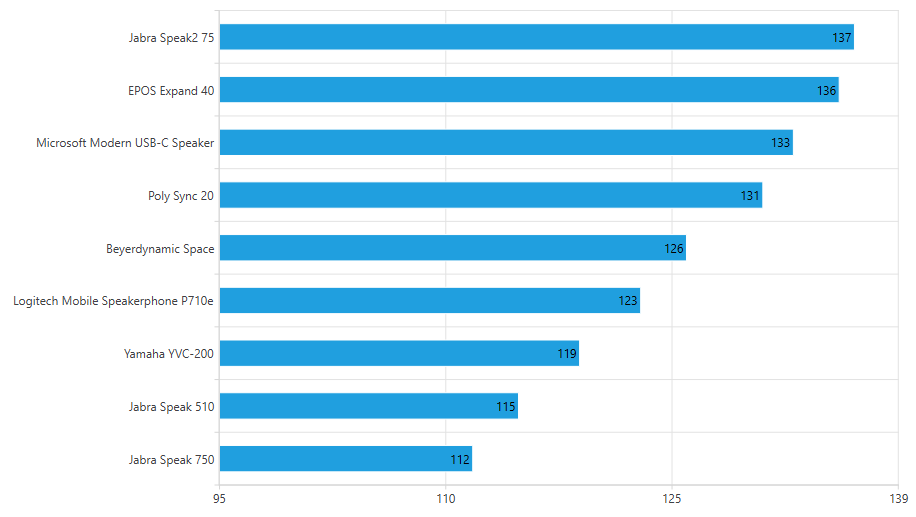 Two speakerphones came out on top: the Jabra Speak2 75 and the EPOS Expand 40.
Two speakerphones came out on top: the Jabra Speak2 75 and the EPOS Expand 40.
The Jabra Speak2 75 earned the top spot in the ranking, with improvements in all audio aspects over the Jabra Speak 750. The Jabra Speak2 75 had the best performance in multimedia playback and videocall capture, making it an excellent choice not only for office or personal video calls but also for listening to some music in between meetings.
Just behind the Jabra Speak2 75 was the EPOS Expand 40. EPOS, which was previously part of Sennheiser Communications, managed an excellent tuning of the capture performance, especially in meetings with multiple people taking part.
Both the Microsoft Modern USB-C Speaker (3rd) and the Poly Sync20 (4th) deserve an honorable mention, being among the most affordable speakerphones tested, while both performing admirably, especially for the capture side on the Microsoft device and the playback side for the Poly device.
Detailed results
Jabra Speak2 75
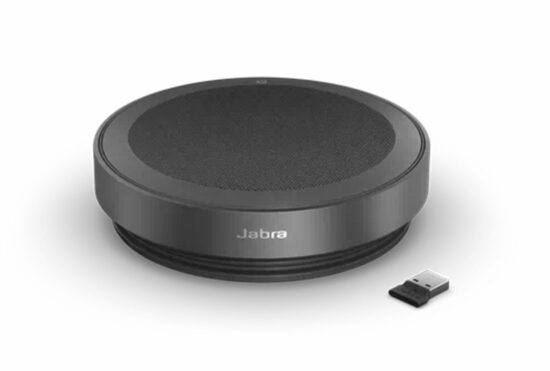 The Speak2 75 performed very well in multimedia playback performance, proving useful for music and movie use, thanks to warm tonal balance and good clarity. Alongside its playback performance, its microphones produced a very pleasant sonority in general. Voices recorded in our test had nice timbre and sounded natural; the only downside was the monophonic nature of the recordings, which made localizability a bit trickier. The device efficiently reduced background noise, leading to a satisfying SNR, although the digital signal processing (DSP) was less efficient when dealing with reverberant acoustics. An all-round good performance for this speakerphone.
The Speak2 75 performed very well in multimedia playback performance, proving useful for music and movie use, thanks to warm tonal balance and good clarity. Alongside its playback performance, its microphones produced a very pleasant sonority in general. Voices recorded in our test had nice timbre and sounded natural; the only downside was the monophonic nature of the recordings, which made localizability a bit trickier. The device efficiently reduced background noise, leading to a satisfying SNR, although the digital signal processing (DSP) was less efficient when dealing with reverberant acoustics. An all-round good performance for this speakerphone.
Pros
- Microphone has an excellent sonority
- Excellent multimedia playback performance
- Very efficient background noise reduction
Cons
- Monophonic recording makes it hard to identify and localize voices
- SNR not as efficient in reverberating acoustical environments
EPOS Expand 40
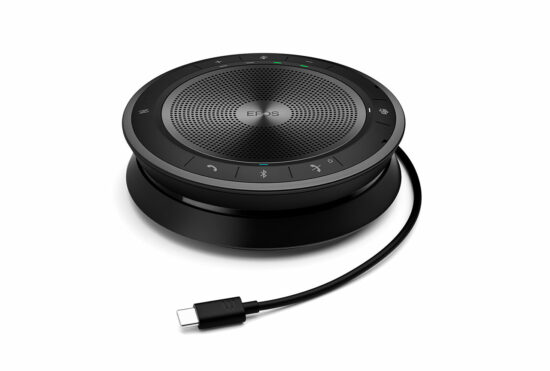 The Expand 40 had nice, if somewhat dark, sonority during playback. Although not necessarily the best choice for multimedia consumption, voices sounded natural and warm. Capture performance was a bit less satisfying, due to voices sounding muffled, and recordings being monophonic. However, the speakerphone functioned particularly well in duplex speech situations, and its handling of artifacts was satisfactory in both playback and capture.
The Expand 40 had nice, if somewhat dark, sonority during playback. Although not necessarily the best choice for multimedia consumption, voices sounded natural and warm. Capture performance was a bit less satisfying, due to voices sounding muffled, and recordings being monophonic. However, the speakerphone functioned particularly well in duplex speech situations, and its handling of artifacts was satisfactory in both playback and capture.
Pros
- Great duplex capabilities during video call and meetings
- Good multimedia playback performance
- Very few artifacts
Cons
- Recordings sound muffled
- Monophonic recording makes it hard to localize voices
Microsoft Modern USB-C Speaker
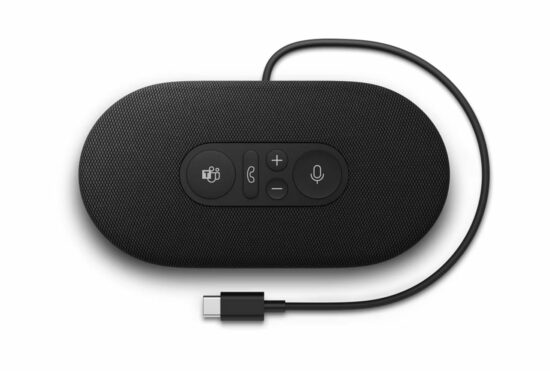 The Microsoft speakerphone provided a good experience overall, especially in capture, where it had a pleasant recording timbre, excellent directivity in the meeting use case, and a satisfying performance in duplex speech situations. The sonority in playback is warm and voices sound good, although they can lack a bit of brilliance and tend to be impaired by either inconsistent noise reduction and/or envelope rendition. The device was also affected by several artifacts in playback and capture alike, but its overall performance was nonetheless satisfactory.
The Microsoft speakerphone provided a good experience overall, especially in capture, where it had a pleasant recording timbre, excellent directivity in the meeting use case, and a satisfying performance in duplex speech situations. The sonority in playback is warm and voices sound good, although they can lack a bit of brilliance and tend to be impaired by either inconsistent noise reduction and/or envelope rendition. The device was also affected by several artifacts in playback and capture alike, but its overall performance was nonetheless satisfactory.
-
Pros
- Good recording timbre
- Excellent directivity in meeting use case
- Great overall performance in duplex speech situations
Cons
- Inconsistent envelope rendition and/or noise reduction during capture
- Artifacts impact the quality of playback and recording
Poly Sync20
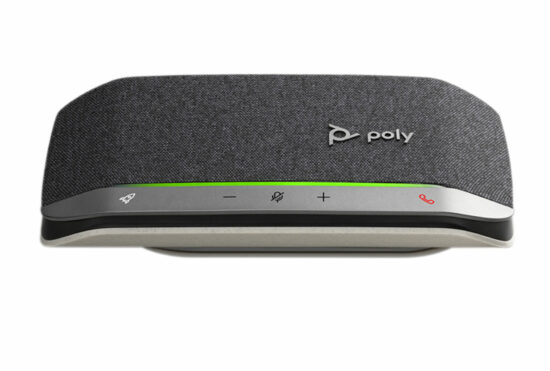
The Poly Sync20 performed very well across the board. Its playback capabilities made for pleasant and intelligible voice rendition and warm tonal balance – enhanced by a strong presence of low end, which made it especially good for multimedia use. Timbre rendition through its microphones was not as good, as voices tend to sound a bit aggressive, but it had a very effective background noise rendition, and a directivity well suited for meetings.
The device’s microphones did not handle duplex speech particularly well, with quieter voices easily affected by gating.
Pros
- Very good performance in video call and multimedia playback
- Microphone provides excellent directivity for meetings
- SNR is excellent in all capture use cases
Cons
- Captured voices tend to sound aggressive
- Duplex speech is affected by strong gating
Beyerdynamic Space
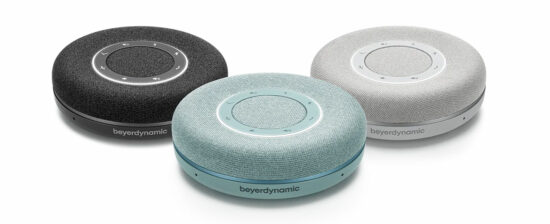 The Beyerdynamic Space has strong playback capabilities, thanks notably to its pleasant and intelligible voice rendition. The speakerphone is also well suited for listening to music, delivering a warm tonal balance and snappy dynamics, especially at loud volumes. You can also use it to watch movies, if you don’t mind the monophonic rendition or the low midrange sounding a bit muddy at times. But all in all, the playback experience is great, and devoid of artifacts.
The Beyerdynamic Space has strong playback capabilities, thanks notably to its pleasant and intelligible voice rendition. The speakerphone is also well suited for listening to music, delivering a warm tonal balance and snappy dynamics, especially at loud volumes. You can also use it to watch movies, if you don’t mind the monophonic rendition or the low midrange sounding a bit muddy at times. But all in all, the playback experience is great, and devoid of artifacts.
As for capture, the device seems promising but leaves room for improvement: audio processing is very efficient at reducing background noise, resulting in great SNR; but although the dynamic envelope is still realistic in most use cases, gating can occur on quieter voices due to background noise reduction going a bit overboard. This becomes especially problematic during duplex speech, as volume drops and other artifacts greatly impair intelligibility. Furthermore, the tonal balance delivered by the microphones lacks both bass and treble to some extent.
Pros
- Very good performance in multimedia playback
- Great SNR in capture
Cons
- Captured voices sound thin (poor timbre rendition)
- Strong gating in duplex speech situations
Logitech Speakerphone P710e
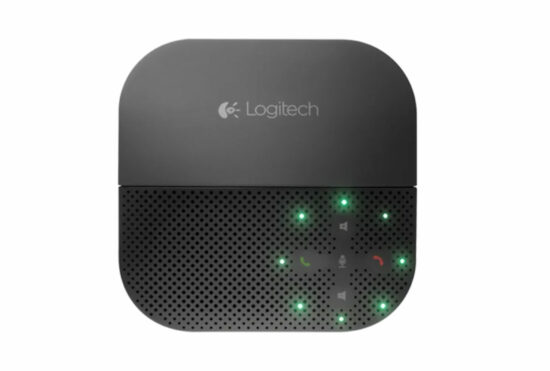 The Logitech speakerphone underperformed in our tests, especially in capture, where unpleasant timbre rendered voices as muddy and unclear. SNR was great, however, but DSP was not efficient enough when it came to reverberant acoustics and duplex speech. As for the playback experience, it provided relatively good sonority for video calls and meetings, but not enough for a good multimedia experience.
The Logitech speakerphone underperformed in our tests, especially in capture, where unpleasant timbre rendered voices as muddy and unclear. SNR was great, however, but DSP was not efficient enough when it came to reverberant acoustics and duplex speech. As for the playback experience, it provided relatively good sonority for video calls and meetings, but not enough for a good multimedia experience.
Pros
- Great all-round SNR
- Few to no artifacts
Cons
- Poor recording timbre
- Many artifacts during duplex speech
Yamaha YVC-200
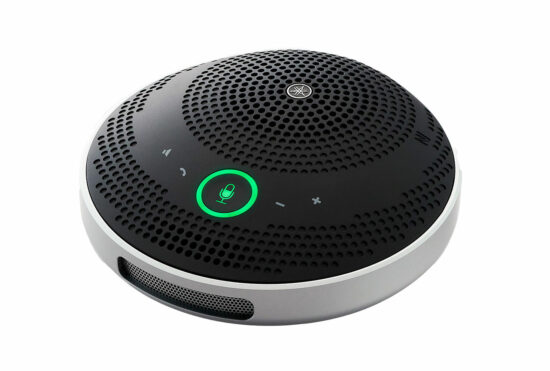 The YVC-200 offers good vocal clarity through its microphone as well as great envelope rendition and intelligibility. Its timbre performance in playback was equally good in video call and meeting use cases, and capture directivity was suitable for both scenarios.
The YVC-200 offers good vocal clarity through its microphone as well as great envelope rendition and intelligibility. Its timbre performance in playback was equally good in video call and meeting use cases, and capture directivity was suitable for both scenarios.
However, background noise was very intrusive in all use cases, to the point where video calls and meetings were less pleasant on the receiving end. The device did not handle duplex speech very well, as both voices were barely intelligible. Finally, music and movies did not sound good on this speakerphone.
Pros
- Very good intelligibility (voices clear in capture)
- Good performance in meeting playback
Cons
- Intrusive background noise in all capture use cases
- Unintelligible duplex speech
- Unsuitable for multimedia purposes
Jabra Speak 510
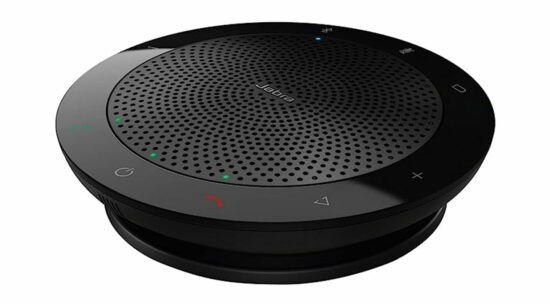
The Jabra 510 does fairly well with video calls, but less so with meetings. While its rendition of speech through its microphone is pleasant and intelligible (thanks to satisfying dynamics), it does not properly capture all voices equally around it, as voices on the sides and to the rear of the speakerphone often sound quieter and more distant than they should. Conversely, this property enhances the experience in one-to-one video calls, as background noise reduction is quite effective, resulting in very good SNR. Duplex speech is nearly impossible, however, as both voices are unintelligible when speaking at the same time. Furthermore, its playback timbre is unsuitable for multimedia content, and distortion is perceptible when listening to music.
Pros
- Great overall SNR in capture
- Decent capture dynamics
Cons
- Not suited for multimedia purposes
- Very strong gating in duplex use cases
Jabra Speak 750
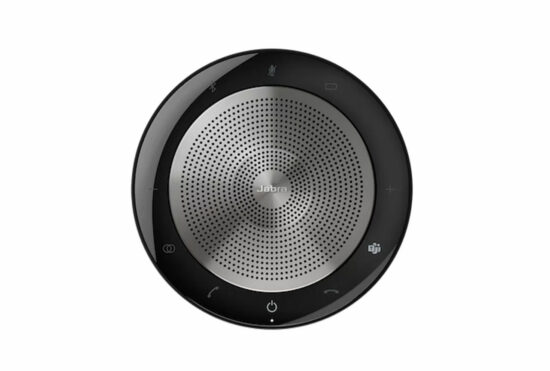
The Jabra 750 did not perform very well in any of our use cases. Although its microphone directivity was well suited for meetings, its timbre and dynamics performance during capture left much to be desired, with muddy, unclear, and compressed sound that was prone to distortion. The same capture issues were present in video calls, and additionally, microphone directivity was less well adapted. However, background noise reduction was quite effective, and the device handled duplex speech fairly well.
Playback performance was not much better, whether for video calls, meetings, or multimedia usage.
Pros
- Great SNR across all use cases
- Excellent directivity in meeting use case
Cons
- Subpar timbre performance across all capture and playback use cases
- Not suited for multimedia use


